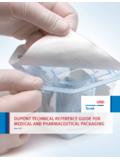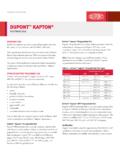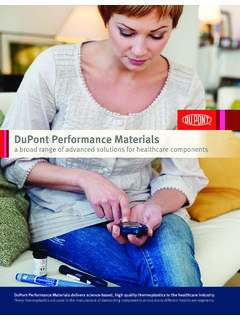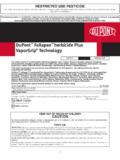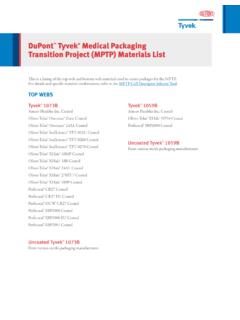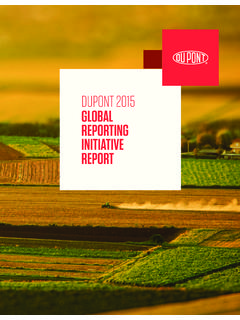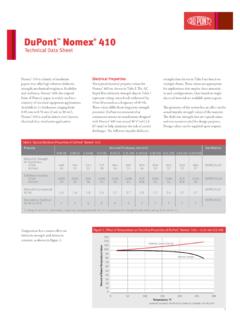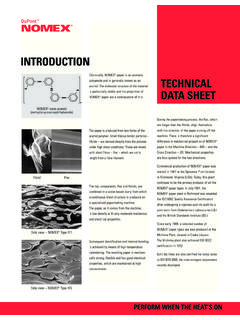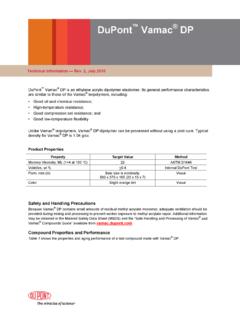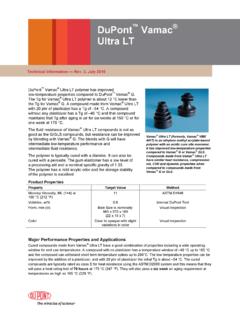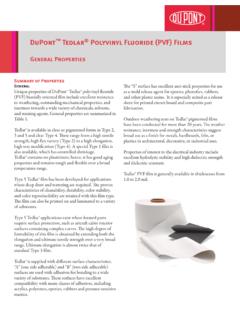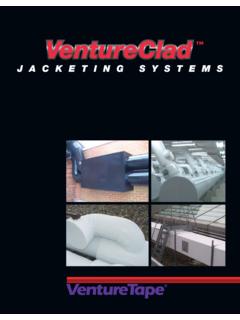Transcription of DUPONT TEDLAR POLYVINYL FLUORIDE FILMS
1 DUPONT TEDLAR POLYVINYL FLUORIDE FILMSADHESIVE AND LAMINATION GUIDEG eneralThis guide is intended to assist the manufacturer in the selection of adhesives for laminating DUPONT TEDLAR POLYVINYL FLUORIDE (PVF) film to a variety of substrates. Lamination and quality control guidelines are also included for laminating TEDLAR PVF film to: Aluminum Galvanized steel Vinyl fabric Thermoplastic sheet Vinyl wall coveringThis information is believed to be the best currently available and is offered to help with your own experimentation and evaluations. This information will be revised as additional information becomes StorageTedlar adhesives are best used within one year of manufacture.
2 Protect the adhesives from temperature and humidity extremes. If adhesives are exposed to temperatures below 4 C (40 F), they must be brought to room temperature, 22 C (70 F), and thoroughly mixed as separate units. Additional mixing is required when blending the , thinned to a desired viscosity with toluene, can be applied to the film using a variety of coating methods. The coated film is normally passed through an oven where the solvent is evaporated to obtain a non-blocking adhesive coating. Thorough drying is essential as residual solvent may cause blocking in the roll. Drying temperatures of 77 104 C (170 220 F) coordinated with proper film web speed and tension are presently being used with success.
3 Excessive machine direction (MD) film stretching and transverse direction (TD) film shrinkage can result from improperly controlled oven temperature and film web Product AdhesivesOver the last 25 years DUPONT has developed a family of adhesives used for laminating TEDLAR PVF film to a wide range of substrates. These adhesives are characterized by excellent resistance to moisture and UV flexible product adhesives are versatile acrylic adhesives developed specifically for laminating TEDLAR PVF film to a variety of substrates. With these adhesives, high-quality, long-lasting bonds can be achieved to meet demanding quality control specifications of blend of acrylic adhesive 68070 and Epon 828 is used to bond TEDLAR PVF film to aluminum and galvanized steel in various adhesive 68080 is a liquid that can be pre-applied to TEDLAR PVF film to facilitate lamination of products for interiors, such as vinyl wall coverings, and for exteriors, such as architectural siding, awnings, flexible sign faces, and fabric CharacteristicsDuPont flexible product adhesives have varying degrees of activation temperature.
4 Amine reactivity, and hardness. Key characteristics of these adhesives are shown below:6808068070 Increasing hardness< <<<<<Increasing amine reactivity>>>>> >Increasing activation temperature < <<<<<Lamination temperature149 - 210 C 300 - 410 F135 - 210 C 275 - 410 FSolvent Composition6808068070 Toluene, %5570 Isopropanol, %4530 DUPONT TEDLAR POLYVINYL FLUORIDE (PVF) FILMSP roduct AdvantagesThese flexible product adhesives have superior durability that resists light, moisture degradation and discoloration. These adhesives are used in a wide variety of substrates and broad range of conditions over many years of LimitationsDuPont TEDLAR adhesives are best used within one year of has been observed to interact with some components in a flame-retardant vinyl causing 828 mixtures only have an 8-hour pot life.
5 68080 is incompatible with solvents should be avoided in diluting the adhesives as yellow discoloration will : DUPONT does not warrant the lamination. The performance of the system is the sole responsibility of the applicator. DUPONT will provide consultation and our best information in assisting the customer to achieve satisfactory PrecautionsThese products are FLAMMABLE AND CONTAIN HARMFUL VAPORS. Store containers away from heat, sparks, and open flames. Keep containers closed when not in use. Before using these products, read the Safety Data Adhesive Selection GuideMetals68070/EpoxyThermoplasticsPoly carbonate68080 or 68070 ABS68080 or 68070 PVC Film68070/Epoxy, 68080 Vinyl Siding68080 Vinyl Wall Covering68080 Flexible Adhesive ApplicationHeat the adhesive to room temperature and mix according to instructions.
6 Dilute with toluene to desired viscosity. Apply adhesive using spray gun, brush, dipping, extrusion, rollers, doctor blade/wire wound rod, reverse roller coater, roller coater or gravure coating. Lamination can proceed as soon as the adhesive is and/or methyl ethyl ketone (for cleanup only) may be used to clean up : Trial laminations should be made to test adhesive suitability. Adhesives, especially non- DUPONT , must be tested for the specific application. Some epoxies may not bond well to the TEDLAR PVF film. The harder polyester adhesives do not bond well to TEDLAR PVF film. Isocyanate curing agents generally enhance adhesion.
7 Some phenolic materials or curing agents may cause staining of the TEDLAR PVF DUPONT TEDLAR PVF Film to AluminumLamination is accomplished by cleaning the metal, depositing a controlled conversion coating on the metal, coating the metal with a solvent-based adhesive, evaporating the solvent, heating the metal to 195 205 C (383 401 F) to activate the adhesive, combining with TEDLAR PVF film in nip rolls and quenching the - TEDLAR PVF film type TWH15BL3 and colorsAdhesive - DUPONT 68070, Epon 828 Metal - AluminumAdhesive Mixing and ApplicationThe adhesive is prepared by the following formula by weight:Adhesive 6807029 Epon 8281 While stirring the 68070, slowly add Epon 828.
8 Blend the mixture for approximately 5 minutes with a suitable mechanical mixer. Adjust adhesive coater to lay down 37 50 m ( to mil) wet adhesive equivalent to 6 m ( to mil) of dry adhesive. Adjust viscosity by diluting with normal operation, the rate of solvent evaporation is slight enough to have no effect on the percent solids. If prolonged halts in coating occur, the viscosity must be checked and adjusted with toluene to the original value. Pot life of the mixed adhesive is 8 solvent is removed and adhesive activated in an oven of such length that the metal is in the oven from 30 to 90 seconds.
9 The metal temperature must be 195 205 C (383 401 F) at the end of the oven followed by immediate laminating equipment consists of a pair of combining or nip rolls that are unaffected by the operating temperature of 175 C (347 F). A nip pressure of 87 175 N/cm (50 100 lb/in) of width must be used. A film wrap of at least 90 on the upper nip roll must be used to prevent TEDLAR POLYVINYL FLUORIDE (PVF) FILMSL aminating DUPONT TEDLAR PVF Film to Galvanized SteelLamination is accomplished by cleaning the metal, depositing a controlled conversion coating on the metal, coating the metal with a solvent-based adhesive, evaporating the solvent, heating the metal to activate the adhesive, combining with TEDLAR PVF film in nip rolls and quenching the - TEDLAR PVF film type TWH15BL3 and colorsAdhesive - DUPONT 68070, Epon 828 Metal - Hot dipped galvanized steel, generally G-90, is steel must have good forming quality and preferably minimum spangle, temper rolled.
10 Lock forming quality or extra smooth metal must be free of white rust to enable proper surface treatment and adhesion. Prior to lamination the metal being used must have all mill oils optimum thickness metal to be laminated is 18 gauge ( ").Laminates on metal, 22 gauge ( ") or lighter, may be made on any standard type of galvanized, including commercial quality, regular spangle. Better forming quality is heavier than 22 ( ") gauge must be minimum spangle or spangle-free surface. Commercial quality, regular spangle steel is not acceptable in gauges heavier than 22 gauge ( "). Care should be taken when laminating metal heavier than 22 gauge ( ") and formed to a radius of less than 3 mm (1/8") to prevent Mixing and ApplicationThe adhesive is prepared by the following formula by weight:Adhesive 6807029 Adhesive Epon 8281 While stirring the 68070, slowly add Epon 828.
